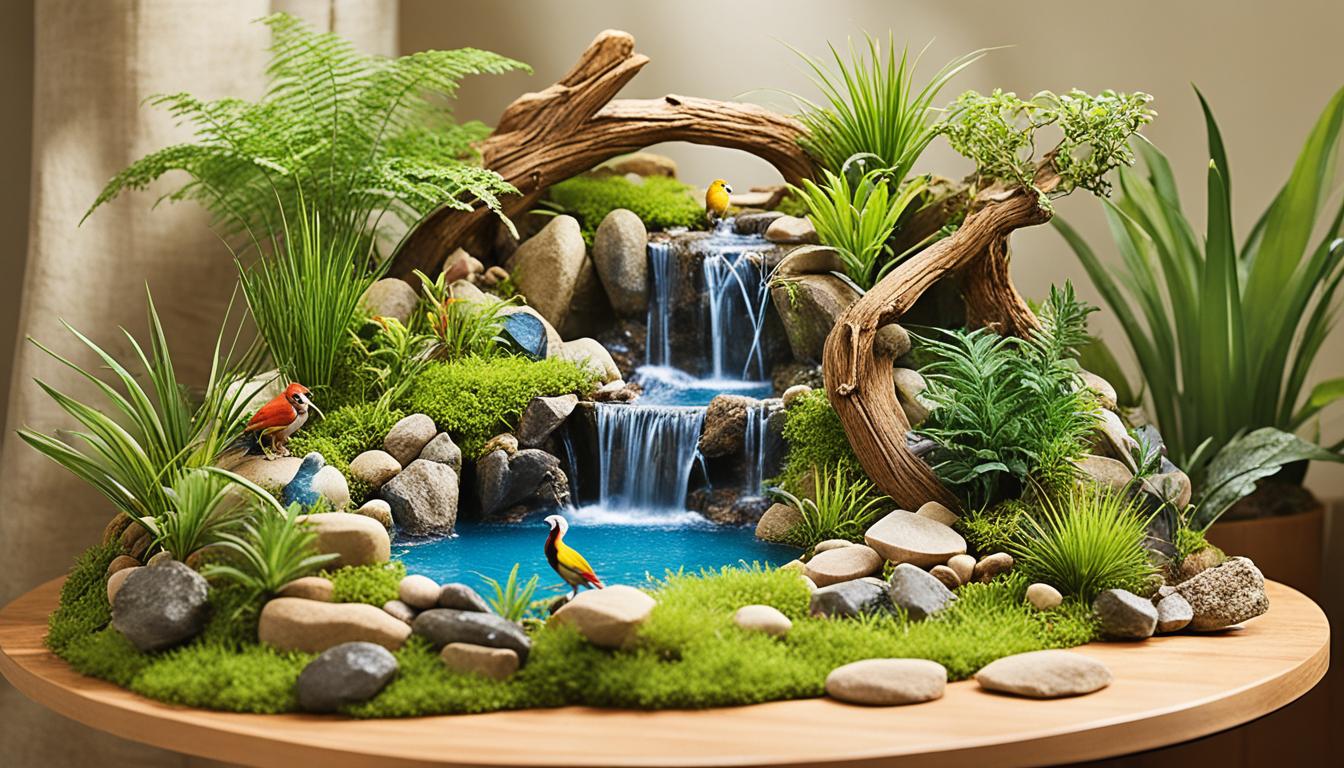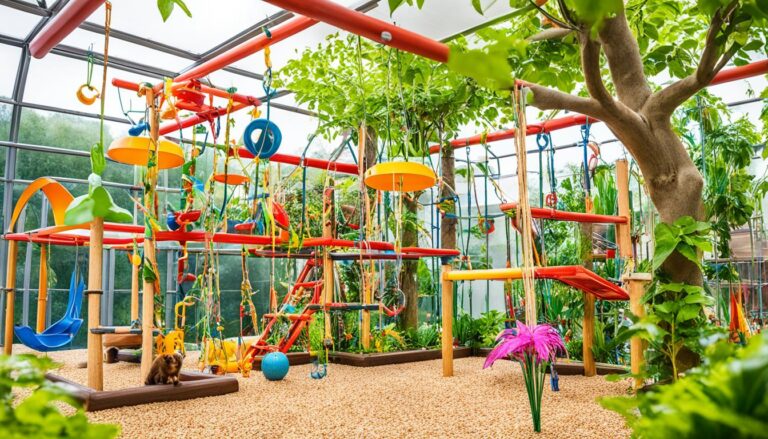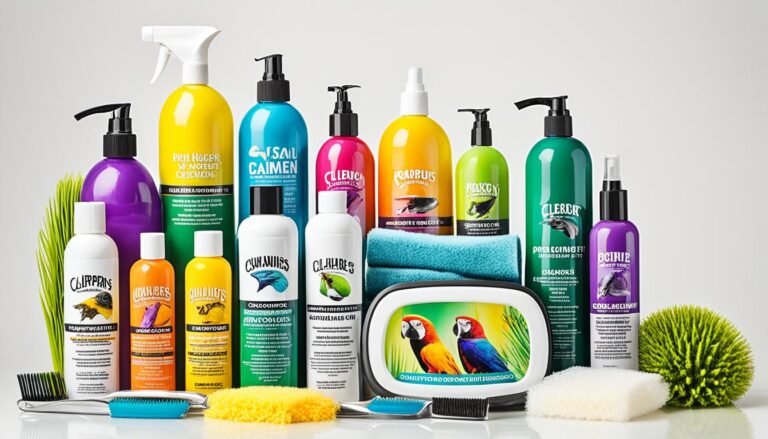Exotic Pet Habitat Ideas & Design Tips
Do you know a well-made home can greatly help your exotic pets’ health and happiness? The perfect space for them is more than good-looking. It needs the right size, materials, and natural parts. Using the best design ideas will make a place that’s enjoyable and healthy for your special pets.
Key Takeaways:
- Designing a suitable habitat is crucial for the well-being of exotic pets.
- Consider factors such as enclosure size, substrate type, and natural elements.
- Explore creative design ideas to mimic their natural habitat.
- Keep exotic pets mentally and physically stimulated with various activities and challenges.
- Incorporate different textures and stimuli to provide sensory enrichment.
Importance of Proper Habitat Setup
Proper habitats are crucial for exotic pets to be healthy and happy. They need room to move, the right amount of light and heat, and a place that feels like home. Here are some tips to make sure your pets’ homes are perfect.
1. Research the Best Habitats for Exotic Pets
Start by learning what each type of exotic pet needs in their home. This includes how big the space should be, what the temperature and humidity should be, and what things should be in it. Knowing this helps you make a place where they will thrive.
2. Provide Sufficient Space for Exploration
All animals need room to be themselves. For exotic pets, this means space for their natural behaviors like climbing or hiding. Ensure the home is big enough for them and the enclosure suits their needs.
3. Ensure Proper Heating and Lighting
The right heat and light are essential for your pets. Find out what’s best for your pet’s species and adjust. Adding the correct lighting will also help them feel at home.
4. Create a Naturalistic Environment
Homelike settings are perfect for exotic pets. Use rocks, plants, and ground cover suitable for them. This also makes their environment stimulating.
5. Offer Environmental Enrichment
Make sure your pets are never bored. Use toys and puzzles to keep them sharp and happy. This is essential for their well-being.
6. Regularly Monitor and Maintain the Habitat
Keep a close eye on your pet’s home. Regular checks make sure the conditions are just right. Cleaning and fixing any damage also keeps your pets safe and cozy.
These tips will help you create the perfect living space for your exotic pets. It ensures they are healthy, happy, and feel at home.
Keep it or Find a New Home
If you can’t care for your exotic pet anymore, you have some options. You could create a special space for them that suits their needs. Or, look for someone new who can care for them. This might mean putting up a post online or in local places. You could also reach out to places like nature centers, schools, or rescue organizations.
Making a unique home for your exotic pet is key for their happiness. With the right design, their home can feel like the natural world. Think about the right temperature, light, bedding, and things to play with. This makes a great living space for your special friend.
If a new home is the best choice, there are many paths you can take. Ads online and in local places can help you find a good match. And don’t forget about places that know a lot about your pet’s type. These include nature centers, schools, and rescue groups that focus on your pet’s kind.
Choosing the right home for your exotic pet is crucial. It’s wise to look into what kind of spaces different pets need. Some like to climb in jungly spaces, and others need room to roam and hide. Gathering this info helps you design the best home for your pet’s health and happiness.
“It’s crucial to prioritize the well-being of your exotic pet when considering rehoming options. Whether you design a custom living space or find a new home, suitability is key.”
When you’re looking for a new owner, give them the details they need to know. Talk about what makes your pet’s space special. Explain how to take good care of them. This shows potential adopters that you care and want the best for your pet.
Return to the Pet Store
If you find you can’t take care of an exotic pet, the pet store might be a good option. Some stores let you return the pet. You won’t get money back, but this is better than bad alternatives.
Returning a pet means it can find a new, caring owner. This helps the pet and stops harm to local wildlife. It also protects the ecosystem.
Stylish Pet Habitat Layout Ideas
Want a stylish home for your pet? There are many ideas. Try these:
- Using visually appealing natural materials such as wood and stone
- Incorporating decorative elements like plants or artwork
- Creating different levels or platforms for your pet to explore
- Adding unique features like tunnels or hideouts
By using these ideas, your pet’s home can be beautiful. It will be a great space for your pet and your home.
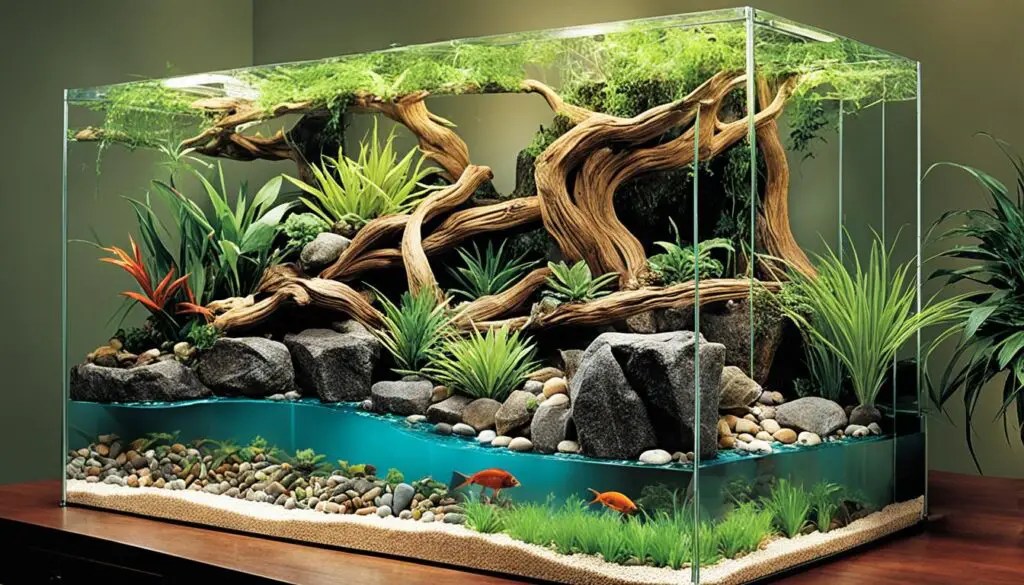
Contact Local Animal Control
Getting the best setup for your exotic pet is key. Local animal control may not take exotic pets, but they can give advice. They might recommend good local places that will take your pet.
Animal control knows about places that welcome exotic animals. They can offer tips for setting up the right home for your pet. Talking to them can help you find a good place for your pet to live.
If you need new ideas for your pet’s space or just need to know how to set it up right, talk to animal control. They are the first step in getting your exotic pet to a new home. They’ll make sure your pet gets the care and space it needs.
Top Tips for Setting Up Pet Habitats:
- Research the specific habitat requirements of your exotic pet species.
- Ensure the enclosure size is adequate for your pet’s natural behavior and growth.
- Provide proper heating and lighting to mimic their natural habitat.
- Incorporate natural elements like rocks, branches, and plants for stimulation and enrichment.
- Regularly monitor temperature, humidity, and cleanliness to maintain optimal living conditions.
- Consult with a veterinarian specializing in exotic pets for additional advice and care tips.
Contact State Wildlife Agency
If you want to find a new home for your exotic pet, talk to your local state wildlife agency. They know all about exotic animals, so they can help. They’ll connect you with places that take in exotic pets.
These agencies know a lot about places like nature centers and rescue groups. They can help find a good home for your pet. They’ll also give advice on how to set up the perfect home for your exotic pet.
In some places, they have events called Amnesty Days. On these days, people can drop off their exotic pets. This way, the pets can find new homes where they’ll be well taken care of.
If you’re not sure what to do, reach out to your state wildlife agency. They offer help and information. They want to make sure your pet is safe and happy.
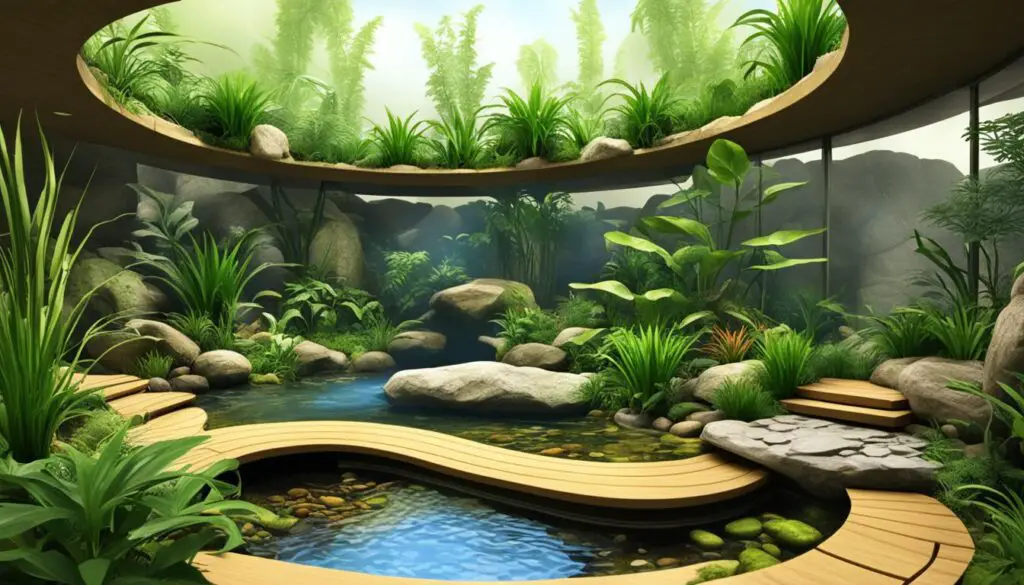
State Wildlife Agencies Contact Information
| State | Contact Information |
|---|---|
| California | California Department of Fish and Wildlife Phone: (555) 123-4567 Email: info@wildlife.ca.gov |
| Texas | Texas Parks and Wildlife Department Phone: (555) 987-6543 Email: contact@tpwd.gov |
| Florida | Florida Fish and Wildlife Conservation Commission Phone: (555) 432-1098 Email: info@myfwc.com |
Consider Euthanasia as a Last Resort
Taking care of exotic pets is usually rewarding. But, there are times when euthanasia might be best for them. It’s a hard choice, only to be made after trying everything else.
If you ever have to consider euthanasia, talk to a vet who knows about exotic animals. They will guide you. They’ll make sure the process is gentle, putting your pet’s comfort first.
Remember, euthanasia is the last option. Try very hard to find another good home first. Always look for other ways before choosing this path.
“Deciding to euthanize a pet is hard, especially when there are no other choices. Talk to a vet who cares. They can help ease this tough decision.”
— Dr. Samantha Carter, Exotic Animal Veterinarian
The Ethics of Euthanasia
Euthanasia sparks a lot of debate. People have different views. But, thinking about your pet’s current life is key. If your pet is in extreme pain, very sick, or not likely to get better, euthanasia might truly be the kindest step.
When deciding about euthanasia, think deeply about their well-being and happiness. It’s important to talk to experts. They can help make sure your choice is what’s best for your pet.
Supporting Resources
Need to make a tough decision like euthanasia? Support is out there. Groups like the Exotic Animal Rescue Network are ready to help. They offer advice and a listening ear for exotic pet owners.
| Support Resources for Exotic Pet Owners |
|---|
| 1. Exotic Animal Rescue Network |
| 2. Online forums and communities |
| 3. Exotic pet care hotlines |
| 4. Local veterinarians specializing in exotic pets |
The Dangers of Releasing Exotic Pets
Setting exotic pets free is risky and against the law in many areas. It’s important to know the dangers and bad outcomes of this action. Putting pets in new places can be dangerous for them. It also harms local animals and plants.
Exotic animals don’t do well in the wild. They can’t find food, homes, or protect themselves. Their survival chances are low in these conditions.
Also, they might harm natural life by using up resources or spreading sickness. This can hurt the balance of nature and lower the number of different plants and animals.
Being a good pet owner means finding good homes for your animal. Here are some good choices:
- Look for a safe place at a known rescue for exotic animals.
- Ask places like zoos or schools if they can take your pet.
- Take help from groups that focus on exotic pets.
- As a last choice, talk to a vet about humane euthanasia. This tough step stops suffering and protects nature.
Being responsible means not letting exotic pets go in the wild. This helps both the pets and their natural homes.
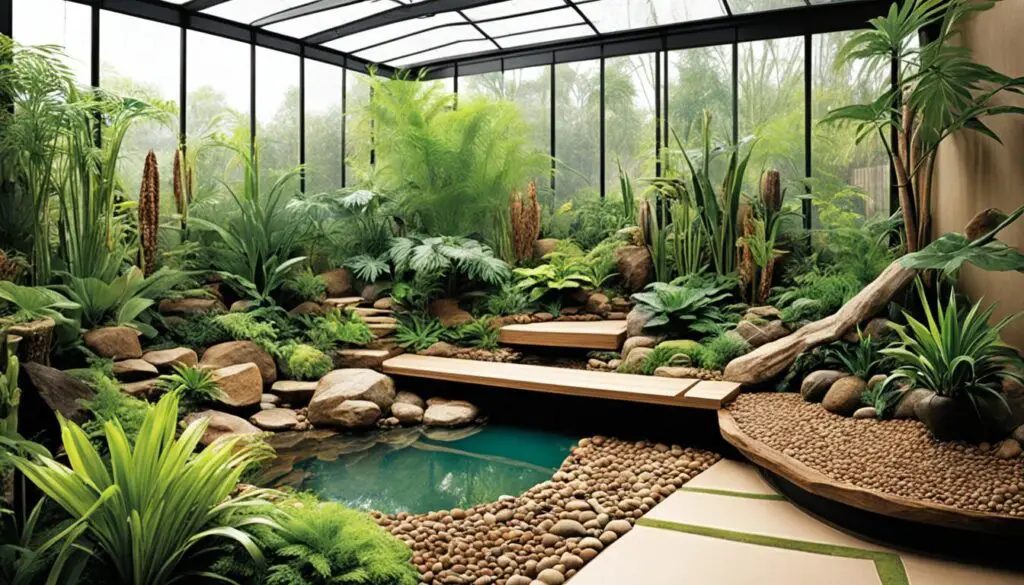
Creating a Natural Habitat
Designing an exotic pet habitat is all about making a natural environment. Use natural terrains, plants, and substrates. These things make a home that looks like where your pet comes from.
Think about creative pet habitat designs that look like your pet’s home. A tropical rainforest might remind you of a reptile’s home. So, add lush vegetation and trees. This makes the space beautiful and fun for your pet.
“A natural habitat not only appeals to the eye but is also essential for the well-being of your exotic pet.”
Adding the right decorations makes the place feel more natural. Choose decorations that match your pet’s home and offer places to hide or climb. For a desert animal, use rocks, sand, and caves. This makes the home look good and feel safe.
It helps to have creative pet enclosure ideas to surprise your pet. Things like puzzle feeders or tunnels keep them entertained. It also helps them use their brain and natural skills.
Always learn what your exotic pet needs and create a space like their natural home. This makes a happy and healthy place for your special friend.
Keeping Pets Busy and Stimulated
To prevent boredom and boost the well-being of your exotic pets, keeping them active is key. You should offer various activities in their space. This will bring out their natural behaviors and improve their health.
Top Tips for Setting Up Pet Habitats
- Include rocks and branches for your pets to climb over, creating a stimulating environment that mimics their natural habitat.
- Set up tunnels and hiding spots to encourage exploration and provide a sense of security.
- Introduce puzzle toys that require problem-solving skills, helping to keep your pets mentally stimulated.
- Provide a variety of toys that offer different textures, shapes, and sounds to add sensory enrichment to their daily routine.
- Rotate toys and activities regularly to prevent boredom and maintain your pets’ interest.
Innovative Pet Enclosure Concepts
“Enrichment activities are essential in keeping your exotic pets happy and healthy. By providing innovative enclosure concepts, you create an environment that encourages natural behaviors and mental stimulation.” – Dr. Sarah Anderson, Exotic Pet Specialist
By adding new enclosure concepts like interactive feeding stations or climbing walls, you make a fun home for your pets. This approach fights off boredom and supports their health and activity levels.
Stylish Pet Habitat Setups
Make your pet’s space look great with stylish touches that go well with your home. Choose enclosures that have a modern look and use natural-like materials. This will give your pet’s area a unified and stylish feel.
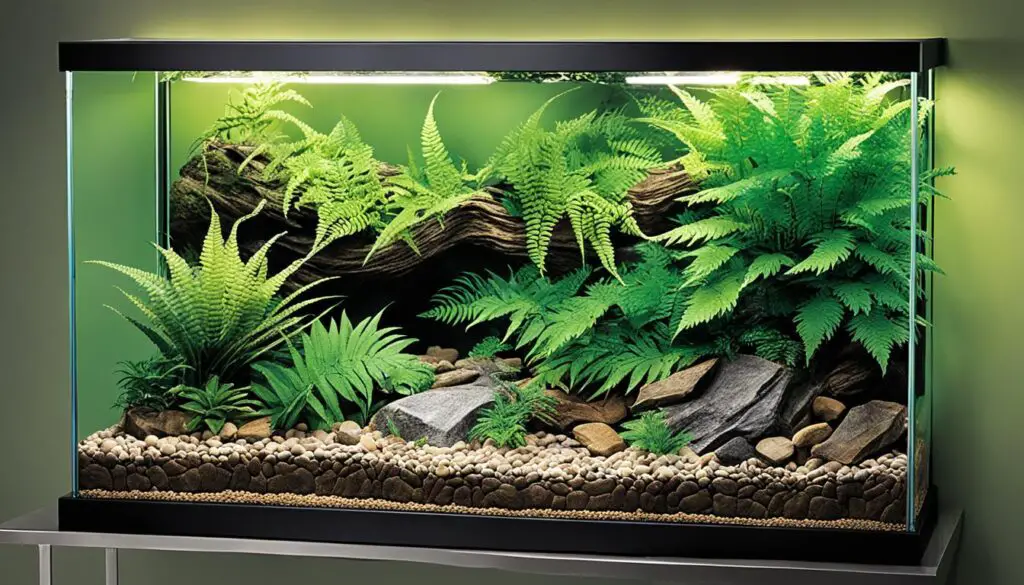
| Activity | Description |
|---|---|
| Rock Climbing | Include different sizes and shapes of rocks to encourage climbing and provide exercise for your pets. |
| Tunnel Exploration | Build tunnels using materials like PVC pipes or natural logs to offer hiding spaces and avenues for exploration. |
| Puzzle Toys | Offer toys with hidden treats or interactive puzzles that require problem-solving skills, providing mental stimulation. |
| Sound Toys | Include toys that produce different sounds, such as squeaks or rattles, to captivate your pet’s attention. |
| Rotating Toys | Regularly rotate toys to maintain novelty and prevent your pets from becoming bored with their surroundings. |
Importance of Texture and Variety
Having different textures in a pet’s home matters a lot for exotic animals. Use things like cork bark, various rocks, and plants. It makes your pet’s home feel more like their wild one. Plus, it makes them feel good.
Reptiles such as snakes and lizards like different textures. It makes them comfortable and happy. Use a mix of soft and hard ground to make their space fun. They will like exploring it.
Think about including these textures for your pet:
- Soft bedding material: Give them a cozy space with things like coconut fiber.
- Rough surfaces: Add rocks or bark for climbing and helping with shedding.
- Smooth surfaces: Place some smooth wood for relaxing or wandering.
- Leaf litter: Put dried leaves down to remind them of their natural homes.
- Live or artificial plants: Place plants with unique textures to hide and look at.
Using many textures makes the pet’s home look good and keeps them happy. It lets them use their natural skills and stops them from getting bored.
Designing a cool and fun home is good for your pet and you. Pick and place textures well to make a great home for your special friend.
Conclusion
It’s vital to create a great home for your exotic pets. You should listen to the experts. Make sure their space looks and feels natural. Include a range of things for them to do.
Think about finding a good new home if you ever need to. This step keeps them and our environment safe. Using new and unique designs will make their space better. It will also look amazing.
With these tips, you can make a perfect home for your exotic pets. It will seem like their real home. They will be happy and healthy. A well-designed home will help you and your pet be closer.
FAQ
What should I consider when setting up a habitat for my exotic pet?
What are some tips for creating the best habitat for exotic pets?
What should I do if I can no longer care for my exotic pet?
Can I return my exotic pet to the pet store?
Should I contact local animal control for help with finding a suitable home for my exotic pet?
Can state wildlife agencies help with rehoming exotic pets?
What should I do if I’ve exhausted all options and euthanasia is the only choice?
Is it okay to release an exotic pet into the wild?
How can I create a natural habitat for my exotic pet?
How can I keep my exotic pets busy and stimulated in their habitat?
Why is texture and variety important in an exotic pet’s habitat?
How important is proper habitat setup for exotic pets?
Source Links
- https://thetyedyediguana.com/blog/reptiles-arent-just-for-looking-at-how-to-keep-your-exotic-pet-happy/
- https://nwdistrict.ifas.ufl.edu/nat/2015/03/06/six-simple-ideas-for-dealing-with-your-unwanted-exotic-pet/
- https://reptifiles.com/colombian-argentine-tegu-care/tegu-enclosure-decor/
Peter Stones is the founder of Exotic Pets Place, the leading online resource for exotic pet care information.
With over 10 years of hands-on exotic pet ownership experience, he is deeply passionate about sharing his expertise to help others properly care for their unusual pets.
When he's not writing extensively researched articles or connecting with fellow exotic pet enthusiasts worldwide, you can find Peter at home tending to his own beloved menagerie of exotic animals.

